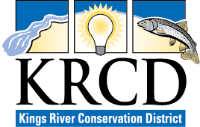
Snow surveys: a critical tool to maximize water supply
Funding is needed for the full suite of snow survey tools that meet 21st century challenges
Every drop of water in California has never been more important. Climate change, tightening constraints from diverse users, and groundwater restrictions in California under SGMA present challenges for water managers balancing supply from year to year. Adequate and consistent funding for the diverse portfolio of complementary snow survey measurements would give water managers a comprehensive toolkit needed to tackle these 21st century challenges and maximize every drop for people, farms, environment, and our groundwater aquifer.
Water management begins in the 1,500 square mile Kings River watershed in the Southern Sierra Nevada, where on average 1.75 million acre-feet of water supply for portions of Fresno, Kings, and Tulare counties is found stored as snow. This supply is extremely variable and in wet years can exceed 4 million acre-feet, swinging below 400,000 acre-feet in the driest years.
Using the available snow survey tools to forecast supply helps water managers make decisions including how much and when to release for all purposes. In California, water demand has dramatically increased in the last 60 years.
On the flipside of growing water demand, water supply availability and timing is impacted by climate change, increasing water management complexity. Every water management decision made in California relies on accurate forecast information. The better initial information the better the final results. Climate science and monitoring are ever evolving. Our forecasting tools need to evolve as well.
According to UCLA climate scientist Daniel Swain , "having wider swings between drought and flood - that might actually be the new normal" ( PPIC ). Steve Haugen, Kings River Watermaster, expresses variability coupled with warmer temperatures creates timing hurdles for water managers.
Adjusting to the new normal could mean adjusting to change in natural water storage capacity found in snowpack, as snow melt patterns change and some precipitation falls as rain rather than snow. This could cause reservoirs to fill quicker and earlier triggering flood release to make room for fast-approaching runoff that otherwise would have been stored in snowpack. Intense precipitation events, " atmospheric rivers ", compound these effects ( UCSD Scripps Oceanography ).
To meet the challenges water managers need data provided by a suite of snow survey tools available today. However, a lack of secure funding for modern snow surveying puts efficient management of a limited resource at risk.
Informed reservoir operations afforded by snow surveys leads to the most efficient use of every drop for people, farms, the environment, and aquifer sustainability. The need to capitalize on available water supply means precision at every stage, from watershed to end use.
Despite the value provided from the full suite of snow survey tools, funding is a hurdle for the program. Beyond local funding for traditional ground sampling, additional state and federal investment is needed for robust data collection that all water managers in the Kings River region, and across California, need to maximize every drop.
StoryMap produced by Kings River Conservation District